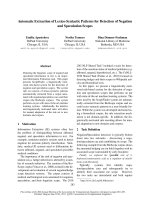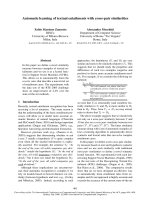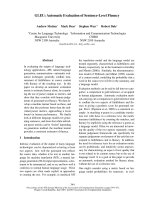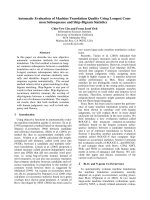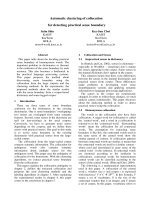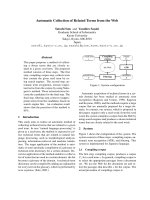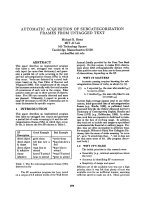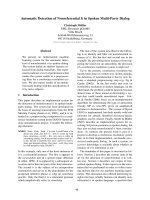Báo cáo khoa học: "Automatic Prediction of Cognate Orthography Using Support Vector Machines" potx
Bạn đang xem bản rút gọn của tài liệu. Xem và tải ngay bản đầy đủ của tài liệu tại đây (185.92 KB, 6 trang )
Proceedings of the ACL 2007 Student Research Workshop, pages 25–30,
Prague, June 2007.
c
2007 Association for Computational Linguistics
Automatic Prediction of Cognate Orthography Using
Support Vector Machines
Andrea Mulloni
Research Group in Computational Linguistics
HLSS, University of Wolverhampton
MB114 Stafford Street, Wolverhampton, WV1 1SB, United Kingdom
Abstract
This paper describes an algorithm to
automatically generate a list of cognates in
a target language by means of Support
Vector Machines. While Levenshtein
distance was used to align the training file,
no knowledge repository other than an
initial list of cognates used for training
purposes was input into the algorithm.
Evaluation was set up in a cognate
production scenario which mimed a real-
life situation where no word lists were
available in the target language, delivering
the ideal environment to test the feasibility
of a more ambitious project that will
involve language portability. An overall
improvement of 50.58% over the baseline
showed promising horizons.
1 Introduction
Cognates are words that have similar spelling and
meaning across different languages. They account
for a considerable portion of technical lexicons,
and they found application in several NLP
domains. Some major applications fields include
relevant areas such as bilingual terminology
compilation and statistical machine translation.
So far algorithms for cognate recognition have
been focussing predominantly on the detection of
cognate words in a text, e.g. (Kondrak and Dorr
2004). Sometimes, though, the detection of
cognates in free-flowing text is rather impractical:
being able to predict the possible translation in the
target language would optimize algorithms that
make extensive use of the Web or very large
corpora, since there would be no need to scan the
whole data each time in order to find the
correspondent item. The proposed approach aims to
look at the same problem from a totally different
perspective, that is to produce an information
repository about the target language that could then
be exploited in order to predict how the
orthography of a “possible” cognate in the target
language should look like. This is necessary when
no plain word list is available in the target language
or the list is incomplete. The proposed algorithm
merges for the first time two otherwise well-known
methods, adopting a specific tagger implementation
which suggests new areas of application for this
tool. Furthermore, once language portability will be
in place, the cognate generation exercise will allow
to reformulate the recognition exercise as well,
which is indeed a more straightforward one. The
algorithm described in this paper is based on the
assumption that linguistic mappings show some
kind of regularity and that they can be exploited in
order to draw a net of implicit rules by means of a
machine learning approach.
Section 2 deals with previous work done on the
field of cognate recognition, while Section 3
describes in detail the algorithm used for this study.
An evaluation scenario will be drawn in Section 4,
while Section 5 will outline the directions we
intend to take in the next months.
2 Previous Work
The identification of cognates is a quite challenging
NLP task. The most renowned approach to cognate
recognition is to use spelling similarities between
the two words involved. The most important
contribution to this methodology has been given by
Levenshtein (1965), who calculated the changes
needed in order to transform one word into another
by applying four different edit operations – match,
25
substitution, insertion and deletion – which became
known under the name of edit distance (ED). A
good case in point of a practical application of ED
is represented by the studies in the field of lexicon
acquisition from comparable corpora carried out by
Koehn and Knight (2002) – who expand a list of
English-German cognate words by applying well-
established transformation rules (e.g. substitution
of k or z by c and of –tät by –ty, as in German
Elektizität – English electricity) – as well as those
that focused on word alignment in parallel corpora
(e.g. Melamed (2001) and Simard et al. (1999)).
Furthermore, Laviosa (2001) showed that cognates
can be extremely helpful in translation studies, too.
Among others, ED was extensively used also by
Mann and Yarowsky (2001), who try to induce
translation lexicons between cross-family
languages via third languages. Lexicons are then
expanded to intra-family languages by means of
cognate pairs and cognate distance. Related
techniques include a method developed by
Danielsson and Mühlenbock (2000), who associate
two words by calculating the number of matching
consonants, allowing for one mismatched character.
A quite interesting spin-off was analysed by
Kondrak (2004), who first highlighted the
importance of genetic cognates by comparing the
phonetic similarity of lexemes with the semantic
similarity of the glosses.
A general overview of the most important
statistical techniques currently used for cognate
detection purposes was delivered by Inkpen et al.
(2005), who addressed the problem of automatic
classification of word pairs as cognates or false
friends and analysed the impact of applying
different features through machine learning
techniques. In her paper, she also proposed a
method to automatically distinguish between
cognates and false friends, while examining the
performance of seven different machine learning
classifiers.
Further applications of ED include Mulloni and
Pekar (2006), who designed an algorithm based on
normalized edit distance aiming to automatically
extract translation rules, for then applying them to
the original cognate list in order to expand it, and
Brew and McKelvie (1996), who used approximate
string matching in order to align sentences and
extract lexicographically interesting word-word
pairs from multilingual corpora.
Finally, it is worth mentioning that the work
done on automatic named entity transliteration
often crosses paths with the research on cognate
recognition. One good pointer leads to Kashani et
al. (2006), who used a three-phase algorithm based
on HMM to solve the transliteration problem
between Arabic and English.
All the methodologies described above showed
good potential, each one in its own way. This paper
aims to merge some successful ideas together, as
well as providing an independent and flexible
framework that could be applied to different
scenarios.
3 Proposed Approach
When approaching the algorithm design phase, we
were faced with two major decisions: firstly, we
had to decide which kind of machine learning (ML)
approach should be used to gather the necessary
information, secondly we needed to determine how
to exploit the knowledge base gathered in the most
appropriate and productive way. As it turned out,
the whole work ended up to revolve around the
intuition that a simple tagger could lead to quite
interesting results, if only we could scale down
from sentence level to word level, that is to
produce a tag for single letters instead of whole
words. In other words, we wanted to exploit the
analogy between PoS tagging and cognate
prediction: given a sequence of symbols – i.e.
source language unigrams – and tags aligned with
them – i.e. target language n-grams –, we aim to
predict tags for more symbols. Thereby the context
provided by the neighbors of a symbol and the
previous tags are used as evidence to decide its tag.
After an extensive evaluation of the major ML-
based taggers available, we decided to opt for
SVMTool, a generator of sequential taggers based
on Support Vector Machines developed by
Gimenez and Marquez (2004). In fact, various
experiments carried out on similar software showed
that SVMTool was the most suitable one for the
type of data being examined, mainly because of its
flexible approach to our input file. Also, SVMTool
allows to define context by providing an adjustable
sliding window for the extraction of features. Once
the model was trained, we went on to create the
most orthographically probable cognate in the
target language. The following sections exemplify
the cognate creation algorithm, the learning step
and the exploitation of the information gathered.
3.1 Cognate Creation Algorithm
Figure 1 shows the cognate creation algorithm in
detail.
26
Input: C1, a list of English-German cognate pairs
{L1,L2}; C2, a test file of cognates in L1
Output: AL, a list of artificially constructed
cognates in the target language
1 for c in C1 do:
2 determine the edit operations to arrive
from L1 to L2
3 use the edit operations to produce a
formatted training file for the SVM tagger
4 end
5 Learn orthographic mappings between L1
and L2 (L1 unigram = instance, L2 n-gram =
category)
6 Align all words of the test file vertically in a
letter-by-letter fashion (unigram = instance)
7 Tag the test file with the SVM tagger
8 Group the tagger output into words and
produce a list of cognate pairs
Figure 1. The cognate creation algorithm.
Determination of the Edit Operations
The algorithm takes as input two distinct cognate
lists, one for training and one for testing purposes.
It is important to note that the input languages need
to share the same alphabet, since the algorithm is
currently still depending on edit distance. Future
developments will allow for language portability,
which is already matter of study. The first sub-step
(Figure 1, Line 2) deals with the determination of
the edit operations and its association with the
cognate pair, as shown in Figure 2. The four
options provided by edit distance, as described by
Levenshtein (1965), are Match, Substitution,
Insertion and Deletion.
toilet/toilette
t |o |i |l |e |t | |
t |o |i |l |e |t |t |e
MATCH|MATCH|MATCH|MATCH|MATCH|MATCH|INS|INS
tractor/traktor
t |r |a |c |t |o |r
t |r |a |k |t |o |r
MATCH|MATCH|MATCH|SUBST|MATCH|MATCH|MATCH
absolute/absolut
a |b |s |o |l |u |t |e
a |b |s |o |l |u |t |
MATCH|MATCH|MATCH|MATCH|MATCH|MATCH|MATCH|DEL
Figure 2. Edit operation association
Preparation of the Training File
This sub-step (Figure 1, Line 3) turned out to be
the most challenging task, since we needed to
produce the input file that offered the best layout
possible for the machine learning module. We first
tried to insert several empty slots between letters in
the source language file, so that we could cope with
maximally two subsequent insertions. While all
words are in lower case, we identified the spaces
with a capital X, which would have allowed us to
subsequently discard it without running the risk to
delete useful letters in the last step of the algorithm.
The choice of manipulating the source language
file was supported by the fact that we were aiming
to limit the features of the ML module to 27 at
most, that is the letters of the alphabet from “a” to
“z” plus the upper case “X” meaning blank.
Nonetheless, we soon realized that the space
feature outweighed all other features and biased the
output towards shorter words. Also, the input word
was so interspersed that it did not allow the
learning machine to recognize recurrent patterns.
Further empirical activity showed that far better
results could be achieved by sticking to the original
letter sequence in the source word and allow for an
indefinite number of feature to be learned. This was
implemented by grouping letters on the basis of
their edit operation relation to the source language.
Figure 3 exemplifies a typical situation where
insertions and deletions are catered for.
START START START START
a a m m
b b a a
i i c k
o o r ro
g g o e
e e e e
n n c k
e e o o
t t n n
i i o o
c X m m
a X i is
l s c ch
l c . END
y h
. END
Figure 3. Layout of the training entries
macroeconomic/makrooekonomisch and
abiogenetically/abiogenetisch, showing insertions
and deletions
As shown in Figure 3, German diacritics have
been substituted by their extended version – i.e. “ö”
as been rendered as “oe”: this was due to the
inability of SVMTool to cope with diacritics.
Figure 3 also shows how insertions and deletions
27
were treated. This design choice caused a non-
foreseeable number of features to be learned by the
ML module. While apparently a negative issue that
could cause data to be too sparse to be relevant, we
trusted our intuition that the feature growing graph
would just flat out after an initial spike, that is the
number of insertion edits would not produce an
explosion of source/target n-gram equivalents, but
only a short expansion to the original list of
mapping pairings. This proved to be correct by the
evaluation phase described below.
Learning Mappings Across Languages
Once the preliminary steps had been taken care of,
the training file was passed on to SVMTlearn, the
learning module of SVMTool. At this point the
focus switches over to the tool itself, which learns
regular patterns using Support Vector Machines
and then uses the information gathered to tag any
possible list of words (Figure 1, Line 5). The tool
chooses automatically the best scoring tag, but – as
a matter of fact – it calculates up to 10 possible
alternatives for each letter and ranks them by
probability scores: in the current paper the reported
results were based on the best scoring “tag”, but the
algorithm can be easily modified in order to
accommodate the outcome of the combination of
all 10 scores. As it will be shown later in Section 4,
this is potentially of great interest if we intend to
work in a cognate creation scenario.
As far the last three steps of the algorithm are
concerned, they are closely related to the practical
implementation of our methodology, hence they
will be described extensively in Section 4.
4 Evaluation
In order to evaluate the cognate creation algorithm,
we decided to set up a specific evaluation scenario
where possible cognates needed to be identified but
no word list to choose from existed in the target
language. Specifically, we were interested in
producing the correct word in the target language,
starting from a list of possible cognates in the
source language. An alternative evaluation setting
could have been based on a scenario which
included a scrambling and matching routine, but
after the good results showed by Mulloni and Pekar
(2006), we thought that yet a different environment
would have offered more insight into the field.
Also, we wanted to evaluate the actual strength of
our approach, in order to decide if future work
should be heading this way.
4.1 Data
The method was evaluated on an English-German
cognate list including 2105 entries. Since we
wanted to keep as much data available for testing
as possible, we decided to split the list in 80%
training (1683 entries) and 20% (422 entries)
testing.
4.2 Task Description
The list used for training/testing purposes included
cognates only. Therefore, the optimal outcome
would have been a word in the target language that
perfectly matched the cognate of the corresponding
source language word in the original file. The task
was therefore a quite straightforward one: train the
SVM tagger using the training data file and –
starting from a list of words in the source language
(English) – produce a word in the target language
(German) that looked as close as possible to the
original cognate word. Also, we counted all
occurrences where no changes across languages
took place – i.e. the target word was spelled in the
very same way as the source word – and we set this
number as a baseline for the assessment of our
results.
Preparation of the Training and Test Files
The training file was formatted as described in
Section 3.1. In addition to that, the training and test
files featured a START/START delimiter at the
beginning of the word and ./END delimiter at the
end of it (Figure 1, Line 6).
Learning Parameters
Once formatting was done, the training file was
passed on to SVMTlearn. Notably, SVMTool
comes with a standard configuration: for the
purpose of this exercise we decided to keep most of
the standard default parameters, while tuning only
the settings related to the definition of the feature
set. Also, because of the choices made during the
design of the training file – i.e. to stick to a strict
linear layout in the L1 word – we felt that a rather
small context window of 5 with the core position
set to 2 – that is, considering a context of 2 features
before and 2 features after the feature currently
examined – could offer a good trade-off between
accuracy and acceptable working times. Altogether
185 features were learnt, which confirmed the
intuition mentioned in Section 3.1. Furthermore,
when considering the feature definition, we decided
to stick to unigrams, bigrams and trigrams, even if
28
up to five-grams were obviously possible. Notably,
the configuration file pictured below shows how a
Model 0 and a global left-right-left tagging option
were applied. Both choices were made after an
extensive empirical observation of several
model/direction combinations. This file is highly
configurable and offers a vast range of possible
combinations. Future activities will concentrate to a
greater extent on the experimentations of other
possible configuration scenarios in order to find the
tuning that performs best. Gimenez and Marquez
(2004) offer a detailed description of the models
and all available options, as well as a general
introduction to the use of SVMtool, while Figure 4
shows the feature set used to learn mappings from a
list of English/German cognate pairs.
#ambiguous-right [default]
A0k = w(-2) w(-1) w(0) w(1) w(2) w(-2,-1)
w(-1,0) w(0,1) w(1,2) w(-1,1) w(-2,2)
w(-2,1) w(-1,2) w(-2,0) w(0,2) w(-2,-1,0)
w(-2,-1,1) w(-2,-1,2) w(-2,0,1) w(-2,0,2)
w(-1,0,1) w(-1,0,2) w(-1,1,2) w(0,1,2) p(-2)
p(-1) p(0) p(1) p(2) p(-2,-1) p(-1,0) p(0,1)
p(1,2) p(-1,1) p(-2,2) p(-2,1) p(-1,2)
p(-2,0) p(0,2) p(-2,-1,0) p(-2,-1,1)
p(-2,-1,2) p(-2,0,1) p(-2,0,2) p(-1,0,1)
p(-1,0,2) p(-1,1,2) p(0,1,2) k(0) k(1) k(2)
m(0) m(1) m(2)
Figure 4. Feature set for known words (A0k). The
same feature set is used for unknown words (A0u),
as well.
Tagging of the Test File and Cognate Generation
Following the learning step, a tagging routine was
invoked, which produced the best scoring output
for every single line – i.e. letter or word boundary –
of the test file, which now looked very similar to
the file we used for training (Figure 1, Line 7). At
this stage, we grouped test instances together to
form words and associated each L1 word with its
newly generated counterpart in L2 (Figure 1, Line
8).
4.3 Results
The generated words were then compared with the
words included in the original cognate file.
When evaluating the results we decided to split
the data into three classes, rather than two: “Yes”
(correct), “No” (incorrect) and “Very Close”. The
reason why we chose to add an extra class was that
when analysing the data we noticed that many
important mappings were correctly detected, but
the word was still not perfect because of minor
orthographic discrepancies that the tagging module
did get right in a different entry. In such cases we
felt that more training data would have produced a
stronger association score that could have
eventually led to a correct output. Decisions were
made by an annotator with a well-grounded
knowledge of Support Vector Machines and their
behaviour, which turned out to be quite useful
when deciding which output should be classified as
“Very Close”. For fairness reasons, this extra class
was added to the “No” class when delivering the
final results. Examples of the “Very Close” class
are reported in Table 1.
Original EN Original DE Output DE
majestically majestatetisch majestisch
setting setzend settend
machineries maschinerien machinerien
naked nakkt nackt
southwest suedwestlich suedwest
Table 1. Examples of the class “Very Close”.
In Figure 5 we show the accuracy of the SVM-
based cognate generation algorithm versus the
baseline, adding the “Very Close” class to both the
“Yes” class (correct) and the “No” class (incorrect).
Figure 5. Accuracy of the SVM-based algorithm
vs. the baseline (blue line).
The test file included a total of 422 entries, with
85 orthographically identical entries in L1 and L2
(baseline). The SVM-based algorithm managed to
produce 128 correct cognates, making errors in 264
29
cases. The “Very Close” class was assigned to 30
entries. Figure 5 shows that 30.33% of the total
entries were correctly identified, while an increase
of 50.58% over the baseline was achieved.
5 Conclusions and Future Work
In this paper we proposed an algorithm for the
automatic generation of cognates from two
different languages sharing the same alphabet. An
increase of 50.58% over the baseline and a 30.33%
of overall accuracy were reported. Even if accuracy
is rather poor, if we consider that no knowledge
repository other than an initial list of cognates was
available, we feel that the results are still quite
encouraging.
As far as the learning module is concerned,
future ameliorations will focus on the fine tuning of
the features used by the classifier as well as on the
choice of the model, while main research activities
are still concerned with the development of a
methodology allowing for language portability: as
a matter of fact, n-gram co-occurrencies are
currently being investigated as a possible
alternative to Edit Distance.
References
Chris Brew and David McKelvie. 1996. Word-Pair
Extraction for Lexicography. Proceedings of the
Second International Conference on New Methods in
Language Processing, 45-55.
Pernilla Danielsson and Katarina Muehlenbock. 2000.
Small but Efficient: The Misconception of High-
Frequency Words in Scandinavian Translation.
Proceedings of the 4th Conference of the Association
for Machine Translation in the Americas on
Envisioning Machine Translation in the Information
Future, 158-168.
Jesus Gimenez and Lluis Marquez. 2004. SVMTool: A
General POS Tagger Generator Based on Support
Vector Machines. Proceedings of LREC '04, 43-46.
Diana Inkpen, Oana Frunza and Grzegorz Kondrak.
2005. Automatic Identification of Cognates and False
Friends in French and English. Proceedings of the
International Conference Recent Advances in Natural
Language Processing, 251-257.
Mehdi M. Kashani, Fred Popowich, and Fatiha Sadat.
2006. Automatic Translitteration of Proper Nouns
from Arabic to English. The Challenge of Arabic For
NLP/MT, 76-84.
Philipp Koehn and Kevin Knight. 2002. Estimating
Word Translation Probabilities From Unrelated
Monolingual Corpora Using the EM Algorithm.
Proceedings of the 17th AAAI conference, 711-715.
Grzegorz Kondrak. 2004. Combining Evidence in
Cognate Identification. Proceedings of Canadian AI
2004: 17
th
Conference of the Canadian Society for
Computational Studies of Intelligence, 44-59.
Grzegorz Kondrak and Bonnie J. Dorr. 2004.
Identification of confusable drug names. Proceedings
of COLING 2004: 20
th
International Conference on
Computational LInguistics, 952-958.
Sara Laviosa. 2001. Corpus-based Translation Studies:
Theory, Findings, Applications. Rodopi, Amsterdam.
Vladimir I. Levenshtein. 1965. Binary codes capable of
correcting deletions, insertions and reversals. Doklady
Akademii Nauk SSSR, 163(4):845-848.
Gideon S. Mann and David Yarowsky. 2001. Multipath
Translation Lexicon Induction via Bridge Languages.
Proceedings of NAACL 2001: 2
nd
Meeting of the
North American Chapter of the Association for
Computational Linguistics, 151-158.
I. Dan Melamed. 1999. Bitext Maps and Alignment via
Pattern Recognition. Computational Linguistics,
25(1):107-130.
I. Dan Melamed. 2001. Empirical Methods for
Exploiting Parallel Texts. MIT Press, Cambridge,
MA.
Andrea Mulloni and Viktor Pekar. 2006. Automatic
Detection of Orthographic Cues for Cognate
Recognition. Proceedings of LREC '06, 2387-2390.
Michel Simard, George F. Foster and Pierre Isabelle.
1992. Using Cognates to Align Sentences in Bilingual
Corpora. Proceedings of the 4th International
Conference on Theoretical and Methodological
Issues in Machine Translation, Montreal, Canada, 67-
81.
30
